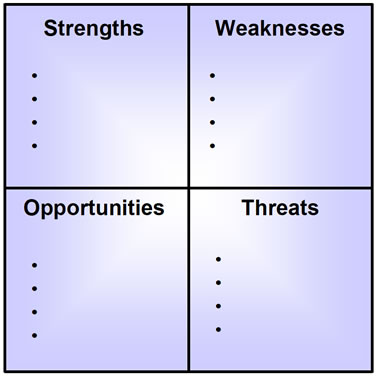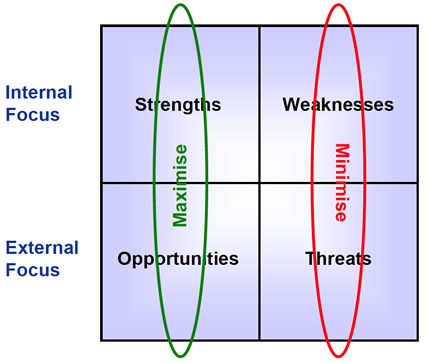SWOT analysis (Strengths, Weaknesses, Opportunities, and Threats) is a simple, proven and well used method of assessing a business, its resources, and its environment. However, most partner account managers would not think of using it as the starting point in a partner or distributor review, nor in the account development process.
This paper takes a fresh look at this simple yet effective tool by using two different approaches. The first is to do the exercise from the perspective of the combined vendor/partner offering (ie. a “Collective SWOT”), rather than the traditional internal management perspective. The second is by adding a “vertical focus” across the tool to create two sets of action items – “MAX” activities (to maximise Strengths & Opportunities) and “MIN” activities (to minimise Weaknesses & Threats).
But first, let’s look at how the SWOT process works in a partner environment.
SWOT Analysis in a Partner Environment
A traditional SWOT Analysis is typically used by an organisation as a strategic planning tool to assess its Strengths, Weaknesses, Opportunities and Threats. It typically involves producing a matrix of four quadrants, one each for each heading, and then listing the relevant factors for your company.

In a partner environment however, the SWOT Analysis needs to factor in your partner(s) and your combined offering. In other words, it is a Collective SWOT. So rather than focussing purely on your own organisation, the Collective SWOT focuses on the internal strengths and weaknesses of your partner, their staff, how they represent your products, and most importantly, how their customers perceive your product offering through that partner. In addition, the Collective SWOT analysis also looks at the external opportunities and threats that may have an impact on their business, but from your partnering perspective, such as market and customer trends, changes in technology, legislation, as well as any financial issues.
When creating a Collective SWOT, don’t worry if some factors appear in more than one box. Sometimes a factor that appears to be a threat could also represent a potential opportunity. For instance, new government legislation requiring compliance to a new standard might threaten you and your partner’s current operations, but at the same time opens up new customers, product opportunities or even alliances. It is just a matter of perspective.
Identify Your Collective Strengths
Take some time to consider what you believe are the strengths of your business and your partner’s business, and how they combine to form something greater than the sum of the parts i.e. 1+1=3. These could be in terms of staff, products, customer market segments, reseller skills, channel programs, process or logistics synergy, locations etc.
Evaluate what you, with or through, your partner’s business do well. For instance it could be an aspect of your channel program. However it is important to try to evaluate your strengths in terms of how they compare to those of your competitors. For example, if all your competitors provide the same training, then this should not be listed as a strength. It should just be considered an operating “hygiene” factor. Whatever you do, you must be totally honest and realistic; there’s no point creating a useless work of fiction!
Recognise Your Collective Weaknesses
Now try to take an objective look at every aspect of your partnership. Ask yourself whether your engagement, products and services offering could be improved. Think about how reliable your customer service is, and whether your partner is always able to deliver what their customers want, when they want it. Try to identify any area of expertise that is lacking in the overall business as you can then take steps to improve that aspect. For example, it could be that your Deal Registration program is very generous, but is so onerous that partners won’t use it.
It’s a good idea to work with your partner on what each others weaknesses really are, as your own perceptions may not always marry up to reality. You may strongly believe that your pre-sales support is the best in the business. Your partner, on the other hand, may perceive that while this maybe technically correct, they are never readily available to work with them to design a customer solution. Be prepared to hear things you may not like, but which, ultimately, may be extremely helpful.
Spot the Collective Opportunities
The next step is to analyse your collective opportunities, and this can be tackled in several ways. External opportunities can include legislative or compliance changes affecting end user customers. This may offer you both an opportunity to provide advice, support, or value added services to better position yourselves as a market leader, if you are quick enough. There may be new products or technology you are releasing that provides new margin or services opportunities for your partner, as well as providing a better “whole product” experience for the end customer.
Another good idea is to consider your collective weaknesses more carefully, and work out ways of addressing the problems, turning them around in order to create an opportunity. For example, if it is agreed that pre-sales support is vital but there are not enough resources, maybe there is the opportunity to re-evaluate responsibilities. For instance, you could recruit a pre-sales engineer to sit within the partner, but is partially funded by the vendor and is fast tracked through certification.
Watch Out for Threats
Analysing the threats to your business partnership requires some guesswork, and this is where your analysis can be overly subjective. Some threats are tangible, such as a new competitor offering, but others may be only intuitive guesses that result in nothing. Having said that, it’s much better to be vigilant, because if a potential threat does eventually become a reality, you’ll be able to react much more quickly. You’ll have considered many of your options already and hopefully also put some contingency planning into place. This is in fact the essence of Game Theory.
Think about the worst things that could realistically happen, such as losing a major joint customer to a previously non threatening competitor. They have a new product range from a recent acquisition and now have a product/technology far superior to your own, with a strong reseller and customer base in your collective “patch”. Listing your threats in your SWOT analysis will provide ways for you to plan to deal with the threats, if they ever actually start to affect your business.
Apply a Vertical Focus
After completing your SWOT analysis, it can be very valuable to apply a “vertical focus” to create two lists of action items – “MAX” activities (to maximise Strengths & Opportunities) and “MIN” activities (to minimise Weaknesses & Threats).

These two lists will then list the “positives” that show the greatest potential to improve the partnership as well as the “negatives” that have the greatest potential to inhibit the partnership. A Strength could be a reseller’s strong vertical market presence, and an Opportunity could be new complex product range being released. The analysis would then yield an action to arrange reseller training on the vendor’s new products as well as arranging a joint marketing program to target the vertical.
These tasks can then be prioritised to see how you can improve the engagement between the two organisations and create a stronger combined product or service offering through your partner.
As you can see, the action you take to build your plan is an interpretation of the data, not the list of SWOT items. This interpretation of the data should allow you to build a partner account development plan now that you understand where your opportunities lie, while not ignoring issues or threats that may de-rail that plan.
The essence of the SWOT analysis is to discover what you and your partner do well, how you could improve, and whether your collective efforts are making the most of the opportunities around you; all the while putting in place contingency plans to deal with the market changes that may arise.
Best Practice Ideas For Channel Managers
- Put yourself in your partner’s shoes and stop focusing only on your products, target or bonus. Your partner will have a choice of multiple suppliers and if there is alignment of ideas, markets, customer requirements and suitable financial incentives then your combined business will grow. Use the joint SWOT as a tool to assess and grow the partnership.
- It will take more than just one person on each side to make this an effective process. Share the SWOT and look for feedback at all appropriate levels and opportunities, especially as part of the quarterly review process. See our other paper “Partner Review Guide” for more details.
- Remember to focus on the “verticals”. Do not try and tackle everything at once as it is not practical or realistic. Pick 2 on each side as a start.
- This process should be a shared process for your major or key accounts but can also be a completed by the key account manager as the preliminary step in building a key account. If this is the case then use what knowledge you have of your partner to try to fill in some of the boxes. Use this as a discussion starting point to see how well you really do understand their business, their view of you as a supplier and your partnership strength.


